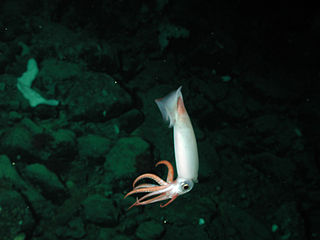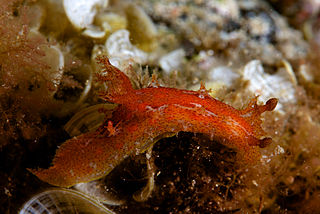
The Noctilucales are an order of marine dinoflagellates. They differ from most others in that the mature cell is diploid and its nucleus does not show a dinokaryotic organization. They show gametic meiosis.

Bioluminescence is the production and emission of light by a living organism. It is a form of chemiluminescence. Bioluminescence occurs widely in marine vertebrates and invertebrates, as well as in some fungi, microorganisms including some bioluminescent bacteria and terrestrial invertebrates such as fireflies. In some animals, a firefly squid has bioluminescence, the light is bacteriogenic, produced by symbiotic organisms such as Vibrio bacteria; in others, it is autogenic, produced by the animals themselves.

The Squaliformes are an order of sharks that includes about 126 species in seven families.

Brachioteuthis is a genus of squid comprising five species.

Chtenopteryx is a genus of small, muscular, midwater squid in the monotypic family Chtenopterygidae. Four species are presently recognized in the genus, but more are believed to exist.

Histioteuthis is a genus of squid and the only member of the Histioteuthidae family. It goes by the common name cock-eyed squid, because in all species the right eye is normal-sized, round, blue and sunken; whereas the left eye is at least twice the diameter of the right eye, tubular, yellow-green, faces upward, and bulges out of the head.

Tomopteris is a genus of marine planktonic polychaetes. All described species are known to be holopelagic, meaning that they spend their entire life cycles in the water column.

Crown jellyfishes are the six families of true jellyfish that belong to the order Coronatae. They are distinguished from other jellyfish by the presence of a deep groove running around the umbrella, giving them the crown shape from which they take their name. Many of the species in the order inhabit deep sea environments.

Galiteuthis is a genus of glass squids from the family Cranchiidae and the subfamily Taoniinae. Squids in the genus Galiteuthis are large squids with mantle lengths measuring up to 660mm, although it has been suggested that mantle length could reach as much as 2.7m. The most distinctive feature of the speciesa in this genus are they have hooks on the tentacular clubs while there are no hooks on the arms, and by their long, thin, terminal fins.

Teuthowenia is a genus of glass squid in the subfamily Taoniinae. Members of this genus are characterized by their deep-sea habitat, clear bodies, and ability to engorge themselves with water to become larger when threatened. Each known species has a visible digestive gland, which serves a similar purpose as a stomach and liver.
Mastigoteuthis is a genus of whip-lash squid containing at least seven valid species. Some teuthologists consider Idioteuthis synonymous with this taxon.
Echinoteuthis is a genus of whip-lash squid containing approximately three to five species. Some teuthologists consider Idioteuthis synonymous with this taxon.
Discoteuthis discus is a species of squids in the family Cycloteuthidae. They occur in the tropical and subtropical Atlantic Ocean and the central North Pacific. While mature specimens have not been found, the unnamed species Discoteuthis sp. A has been hypothesised as the mature form.
Discoteuthis laciniosa is a species of squid in the family Cycloteuthidae. The species occurs throughout the Atlantic, Indian and Pacific Oceans.

Gonatus is a genus of squid in the family Gonatidae, comprising twelve species, and therefore containing the most species in the family. Adult squid belonging to species in this genus are notable for their lack of tentacles.

Plocamopherus is a genus of sea slugs, specifically nudibranchs, shell-less marine gastropod molluscs in the family Polyceridae, subfamily Triophinae. A unique character of Plocamopherus species is a globular bioluminescent organ at the tip of the pair of appendages which are placed just behind the gills. Many species are known to be nocturnal and several are from deep water. They feed on bryozoans.

Bolitaena is a genus of pelagic octopods from the subfamily Bolitaeninae in the family Amphitretidae. It contains two species, a third species Bolitaena microcotyla is now regarded as a synonym of Haliphron atlanticus.

Japetella is a genus of pelagic octopods from the subfamily Bolitaeninae in the family Amphitretidae. It contains at least one species but another two have been questionably raised with Japetella heathi being of doubtful validity, although currently accepted and Japetella taningi being classed as a nomen dubium.
Richard E. Young is a teuthologist. He is an Emeritus Professor of Oceanography at the University of Hawaii's School of Ocean and Earth Science and Technology.














